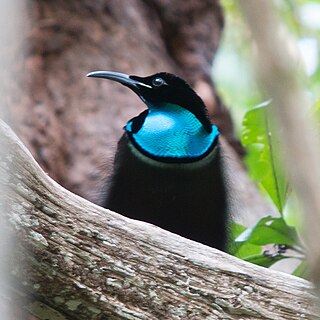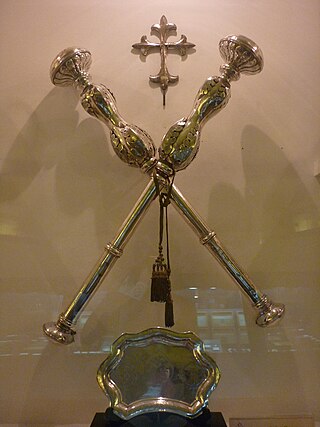
A rector is a senior official in an educational institution, and can refer to an official in either a university or a secondary school. Outside the English-speaking world, the rector is often the most senior official in a university, while in the United States, the equivalent is often referred to as the president, and in the United Kingdom and Commonwealth of Nations, the equivalent is the vice-chancellor. The term and office of a rector can be referred to as a rectorate. The title is used widely in universities in Europe and is very common in Latin American countries. It is also used in Brunei, Macau, Turkey, Russia, Pakistan, the Philippines, Indonesia, Israel and the Middle East. In the ancient universities of Scotland the office is sometimes referred to as Lord Rector, is the third most senior official, and is usually responsible for chairing the University Court.

Abantiades is a genus of moths of the family Hepialidae. There are 37 described species, all found exclusively in Australia. The group includes some large species with a wingspan of up to 160 mm. The larvae feed on the roots of Eucalyptus and other trees. Simonsen's 2018 revision of the Australian Hepialidae synonymized the genera Bordaia and Trictena to Abantiades, and included the former genera's species here.

Montceau-les-Mines is a commune in the Saône-et-Loire department in the region of Bourgogne-Franche-Comté in eastern France.

The magnificent bird-of-paradise is a species of bird-of-paradise. The magnificent bird-of-paradise is evaluated as Least Concern on the IUCN Red List of Threatened Species. They are listed in Appendix II of CITES.

The magnificent riflebird is a species of passerine bird in the birds-of-paradise family Paradisaeidae.

The white-eared night heron is a species of heron in the family Ardeidae. It is found in southern China and northern Vietnam.. It is threatened by habitat loss and habitat fragmentation.

Boden is a locality and the seat of Boden Municipality in Norrbotten County, Sweden with 16,847 inhabitants in 2018. It is part of the larger area around coastal city Luleå some 36 kilometres (22 mi) southeast. After Kiruna, it is the second largest town in Northern Sweden's interior.

Ancylomenes magnificus, also known as the magnificent anemone shrimp, is a species of cleaner shrimp common to the Western Pacific Ocean at depths of 3–29 metres (10–95 ft). They are commonly found on stony coral, Catalaphyllia and the sea anemone, Dofleinia armata.

Chiton magnificus, the liquorice sea cradle, is a Southeast Pacific species of edible chiton, a marine polyplacophoran mollusk in the family Chitonidae, the typical chitons.

Abantiades hyalinatus is a moth of the family Hepialidae. It is found in Australia, from southern Queensland to Tasmania.

Abantiades atripalpis, also known as bardee grub, rain moth or waikerie, and previously known as Trictena atripalpis, is a moth of the family Hepialidae. It is found in the whole southern half of Australia.

Abantiades latipennis, known as the Pindi moth, is a species of moth in the family Hepialidae. It may also be referred to as a swift moth or a ghost moth, as this is a common name associated with Hepialidae. Endemic to Australia and identified in 1932, it is most populous in temperate rainforest where eucalypti are prevalent, as the larvae feed primarily on the roots of these trees. Females lay eggs during flight in a scattering fashion. The larvae live for over eighteen months underground, while adult moths survive for approximately one week, as they have no mouthparts with which to feed. The moths are preyed upon by a number of predators, including bats and owls. Brown in colour overall, males are paler and the identifying silver bars of the male's wings are more prominent than those of the female's, with dark margins. Male adults are generally smaller.

Ornithocercus is a genus of planktonic dinoflagellate that is known for its complex morphology that features considerable lists growing from its thecal plates, giving an attractive appearance. Discovered in 1883, this genus has a small number of species currently categorized but is widespread in tropical and sub-tropical oceans. The genus is marked by exosymbiotic bacteria gardens under its lists, the inter-organismal dynamics of which are a current field of research. As they reside only in warm water, the genus has been used as a proxy for climate change and has potential to be an indicator species for environmental change if found in novel environments.
Abantiades albofasciatus is a moth of the family Hepialidae. It is endemic to Western Australia.
Abantiades aurilegulus is a moth of the family Hepialidae. Samples have only been found in Western Australia.

Abantiades labyrinthicus is a moth of the family Hepialidae. It is endemic to Australia, where it is found in the Australian Capital Territory, New South Wales, Queensland, Tasmania and Victoria.
Abantiades argyrosticha is a species of moth of the family Hepialidae. It was described by Turner in 1929, and is endemic to New South Wales and Queensland.

The Maces of the Rector Magnificus of the University of Santo Tomas (UST) are 17th-century silver maces which are considered to be the oldest symbols of the office Rector Magnificus of the University of Santo Tomas, the oldest extant European-chartered university in Asia.

Eurhinus magnificus, the jewel weevil, is a species of weevil native to Central America. The species was originally described by Leonard Gyllenhaal in 1836.
















